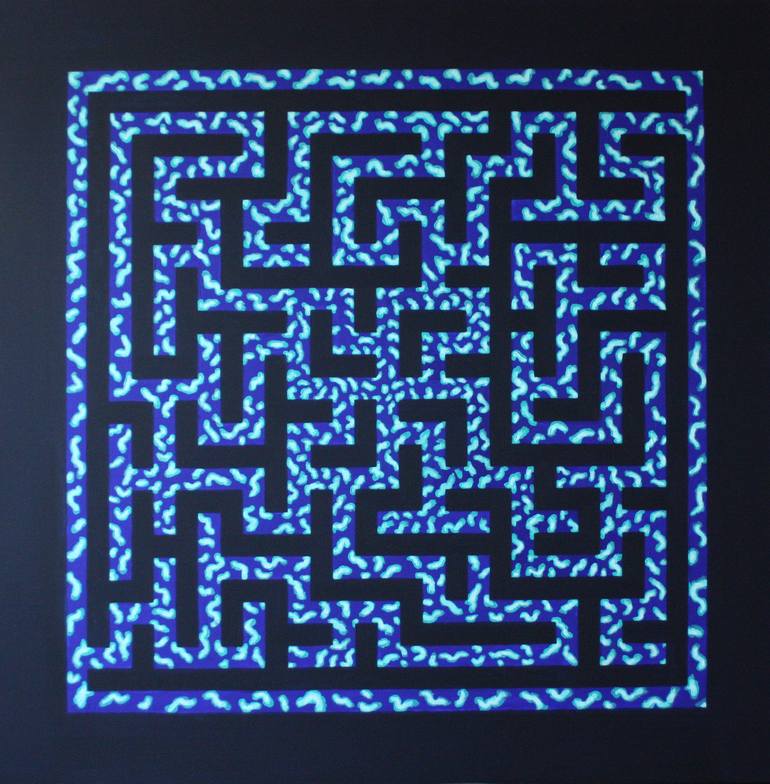


VIEW IN MY ROOM
Blue Labirynth Painting
Norway
Painting, Acrylic on Canvas
Size: 35.4 W x 35.4 H x 1.2 D in
Ships in a Crate
Artist Recognition

Artist featured in a collection
About The Artwork
Prehistoric labyrinths are believed to have served as traps for malevolent spirits or as defined paths for ritual dances. In medieval times, the labyrinth symbolized a hard path to God with a clearly defined center (God) and one entrance (birth). In their cross-cultural study of signs and symbols, "Patterns that Connect", Carl Schuster and Edmund Carpenter present various forms of the labyrinth and suggest various possible meanings, including not only a sacred path to the home of a sacred ancestor, but also, perhaps, a representation of the ancestor him/herself: "...many [New World] Indians who make the labyrinth regard it as a sacred symbol, a beneficial ancestor, a deity. In this they may be preserving its original meaning: the ultimate ancestor, here evoked by two continuous lines joining its twelve primary joints." .[37] Labyrinths can be thought of as symbolic forms of pilgrimage; people can walk the path, ascending toward salvation or enlightenment. Many people could not afford to travel to holy sites and lands, so labyrinths and prayer substituted for such travel. Later, the religious significance of labyrinths faded, and they served primarily for entertainment, though recently their spiritual aspect has seen a resurgence. Many newly made labyrinths exist today, in churches and parks. Labyrinths are used by modern mystics to help achieve a contemplative state. Walking among the turnings, one loses track of direction and of the outside world, and thus quiets the mind. The Labyrinth Society[38] provides a locator for modern labyrinths all over the world. In addition, the labyrinth can serve as a metaphor for situations that are difficult to be extricated from, as an image that suggests getting lost in a subterranean dungeon-like world. Octavio Paz titled his book on Mexican identity The Labyrinth of Solitude, describing the Mexican condition as orphaned and lost. Work is exhibited in BWA Gallery Bielsko-Biala until 1st of September 2013.
Details & Dimensions
Painting:Acrylic on Canvas
Original:One-of-a-kind Artwork
Size:35.4 W x 35.4 H x 1.2 D in
Frame:Not Framed
Ready to Hang:Not applicable
Packaging:Ships in a Crate
Shipping & Returns
Delivery Time:Typically 5-7 business days for domestic shipments, 10-14 business days for international shipments.
Handling:Ships in a wooden crate for additional protection of heavy or oversized artworks. Crated works are subject to an $80 care and handling fee. Artists are responsible for packaging and adhering to Saatchi Art’s packaging guidelines.
Ships From:Poland.
Customs:Shipments from Poland may experience delays due to country's regulations for exporting valuable artworks.
Have additional questions?
Please visit our help section or contact us.
Norway
Polish painter and composer. Born in 1983. Based in Tromsø, Norway. I follow different paths of art expression and that process provides me an opportunity to touch the essence of things, to seize the inexpressible, to introduce the public to sheer experience where logic is not exactly the answer. All the media I work with gives me the possibility to generate new ideas and concepts - no matter whether or not they are illusory. Music and abstract painting, collage and photography are my favorite so far... but I also work with graphic design to stay in touch with my ordered side of personality. To learn more about my inspirations, music and the way I work, please visit my web.
Artist Recognition

Artist featured by Saatchi Art in a collection
Thousands Of Five-Star Reviews
We deliver world-class customer service to all of our art buyers.
Global Selection
Explore an unparalleled artwork selection by artists from around the world.
Satisfaction Guaranteed
Our 14-day satisfaction guarantee allows you to buy with confidence.
Support An Artist With Every Purchase
We pay our artists more on every sale than other galleries.
Need More Help?